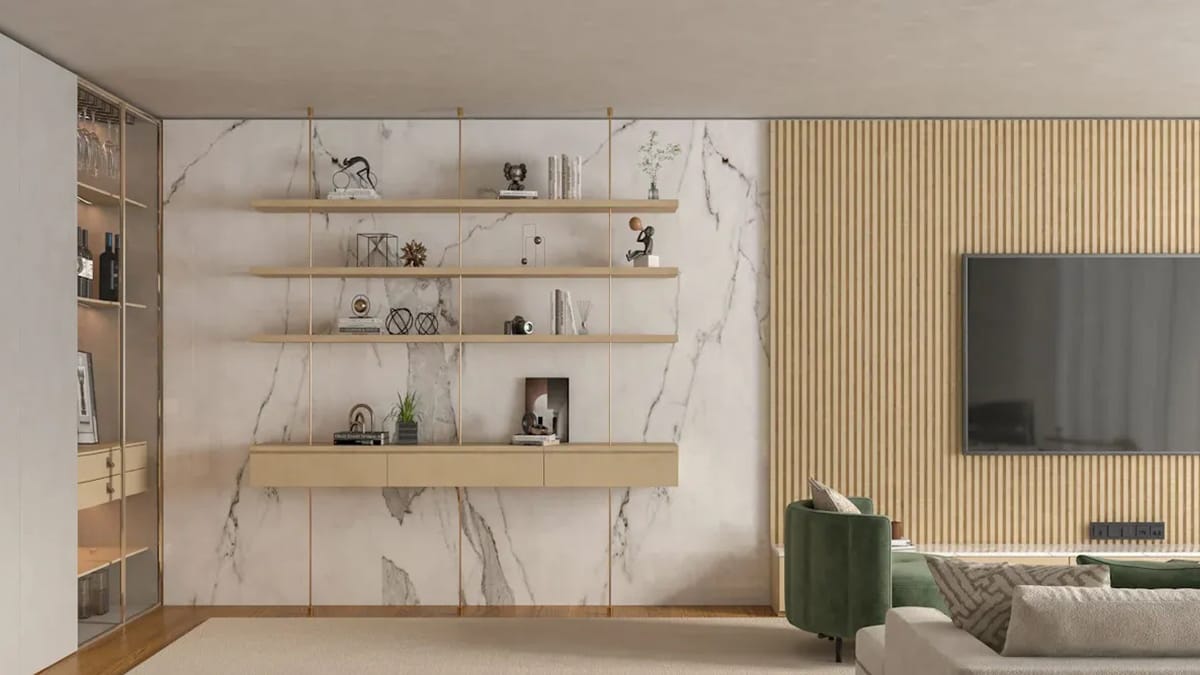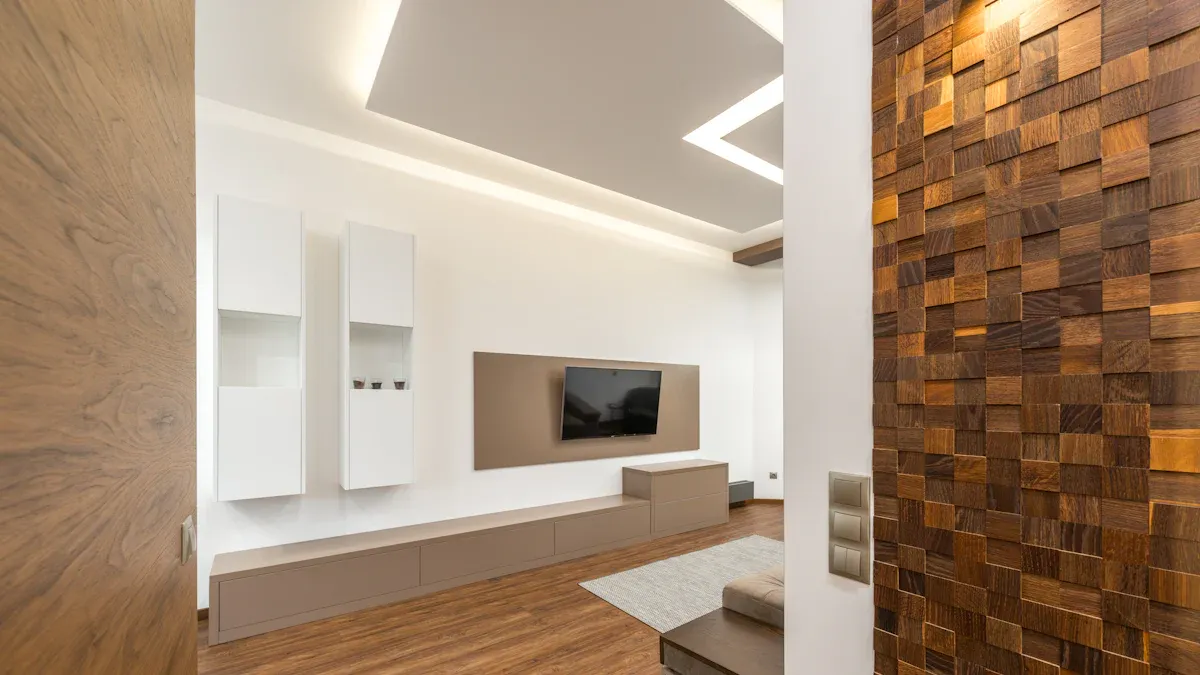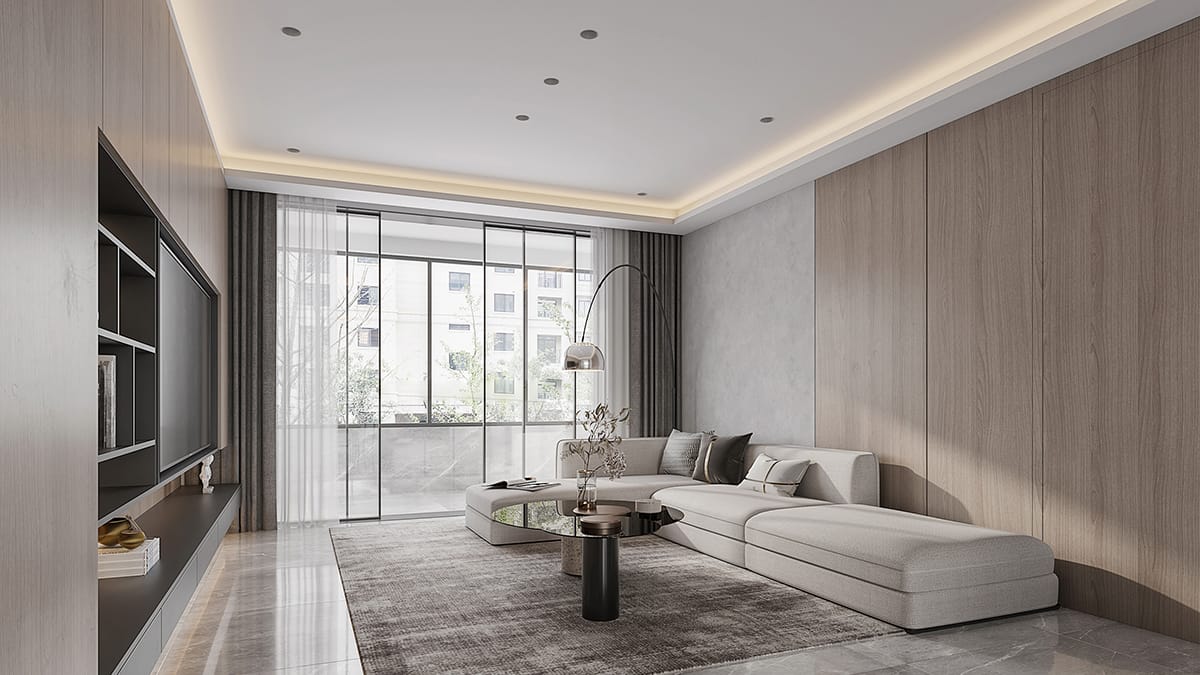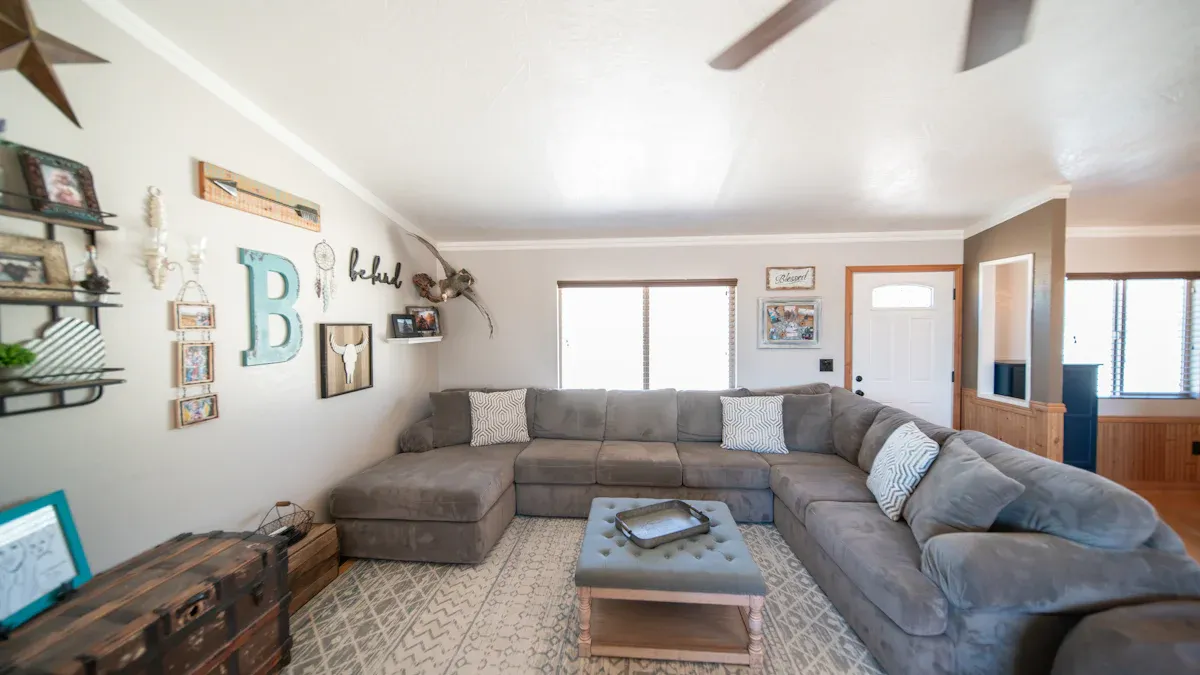
15 Sep Wall Paneling Systems For Modern Interiors
Table of Contents
You might notice more homes and offices using wall paneling systems to add style and function to their walls. These systems use panels made from materials like MDF, wood veneer, metal, PVC, and even fabric. You can pick from trendy options, such as wood slats, shiplap, or 3D panels, to match your taste. Right now, this market is booming:
The wall panel systems market could reach $45.8 billion by 2033, with steady growth each year.
Modern panels bring warmth, improve sound, and turn plain walls into eye-catching features.
Key Takeaways
Wall paneling systems make rooms look nice and work better. They help spaces look good and be useful at the same time.
You can pick from many materials like wood, MDF, PVC, or fabric. Choose what fits your style and what your room needs.
Wall panels have many good points. They help keep rooms warm and quiet. They are also easy to clean. This helps make your room feel nice.
You can put up wall panels by yourself with pre-cut kits. Or you can get a pro to help if it is hard. This gives your walls a smooth look.
Make sure you know what design you want and how much you can spend. This helps you pick the best wall panels for your room.
What Are Wall Paneling Systems?
Definition
Wall paneling systems use panels to cover walls. These panels look nice and do more than decorate. They help make rooms better and more useful. You can get panels made from wood, metal, fabric, or other things. Each kind has its own good points.
Wall paneling systems help make rooms quieter.
They help keep rooms warm or cool.
Some panels do not stain or scratch easily, so they last longer.
Many panels are made ahead of time, so you can put them up fast.
If you want walls that look cool and work well, these systems are a smart choice.
Modern Applications
Wall paneling systems are used in many places now. You see them in homes, offices, and busy public spots. Designers use them to make walls stand out, add texture, or fix problems like noise and heat. Here is how different places use these panels:
Application Area | Material Options |
|---|---|
Gymnasiums | Strong wall panels with fancy trim |
Patient Treatment Areas | Tough laminate for a nice look |
Cafeterias | Hard panels that do not break easily |
Classrooms | Panels you can change and move |
Hallways | Wall panels that work in many ways |
Elevators | Surfaces that are easy to clean |
Lobbies | Walls with pictures that stand out |
Reception Areas | Walls that last and work well |
Many people like eco-friendly materials, with 68% picking them. Panels that help with sound and heat are more important now, especially at home. If you want a fancy look for less money, PVC marble panels are a good pick.
Tip: Try wall paneling systems in a hallway or lobby to make a strong first impression. Mix different materials and colors to match your style.
Benefits of Wall Paneling Systems
 Aesthetic Appeal
Aesthetic Appeal
You want your space to look great, right? Wall paneling systems can help you do just that. They add style and personality to any room. You can choose from many colors, patterns, and textures. Some panels even create cool 3D effects that make your walls pop. Take a look at how these panels boost the look and feel of your space:
Aspect | Description |
|---|---|
Visual Comfort | Panels reduce glare and soften light, making rooms feel cozy. |
Color Variations | Subtle color changes add interest and comfort. |
Environment Suitability | Great for classrooms and healthcare spaces, helping people feel relaxed. |
You can pick panels that match your style, whether you like bold designs or simple looks. The texture and high-quality finish of these panels make your walls stand out and fit modern trends.
Functionality
Wall paneling systems do more than look good. They make your rooms work better for you. Here’s how:
Panels help keep rooms quiet by blocking noise.
They add insulation, so your space stays warm in winter and cool in summer.
You can hide wall flaws, making old walls look new.
Acoustic fabrics in panels improve sound, perfect for music rooms or busy offices.
Panels combine style and function, so you get both beauty and practicality.
You get a space that feels peaceful and comfortable, no matter where you use them.
Value and Comfort
Wall paneling systems can raise the value of your home or office. Buyers love spaces that look modern and feel cozy. Here’s what you gain:
Panels make rooms look more sophisticated, which can impress guests or buyers.
Durable materials resist dents and scratches, so you spend less time fixing walls.
Extra insulation helps control temperature, saving energy and money.
Well-designed panels turn plain rooms into attractive features.
People feel more comfortable in spaces with good wall paneling, and that can boost your mood.
If you want a space that feels inviting and looks amazing, wall paneling systems are a smart choice.
Types of Wall Paneling Systems
 When you look at wall paneling systems, you will see many choices. Each type gives your room a different look and feel. Let’s talk about the most popular options for modern spaces.
When you look at wall paneling systems, you will see many choices. Each type gives your room a different look and feel. Let’s talk about the most popular options for modern spaces.
Wood Panels
Wood panels are a classic pick. They never go out of style. You can choose wood slats, beadboard, shiplap, or board and batten. These panels make rooms feel warm and natural.
Disadvantages of Wood Wall Panels | |
|---|---|
Environmentally friendly | Wood rot |
Renewable resource | Deformation |
Biodegradable | Maintenance |
Insulating properties | May seem dated |
Energy efficient | Can be expensive |
Wooden panels help keep your home warm or cool.
You can use reclaimed wood or bamboo for a greener choice.
Humid rooms can make wood warp or bend.
Sometimes, wood looks old if not styled well.
Tip: For a modern style, try acoustic slat wall panels or simple wood veneer slats. These are very popular in new homes.
MDF Panels
Medium-density fiberboard (MDF) panels have a smooth surface. They are good if you want to paint or add a finish. MDF costs less than solid wood and is easy to cut.
Cons | |
|---|---|
Smooth and uniform surface for finishes | Moisture sensitivity; can swell when wet |
Affordable compared to solid wood | Not as strong as solid wood |
Easy to cut, shape, and install | Can dent easily |
Environmentally friendly option | Heavier than plywood |
MDF panels are great for custom designs.
They are heavier than plywood and can swell if wet.
Be careful using them in bathrooms or kitchens.
PVC Panels
PVC panels are good for wet places like bathrooms or laundry rooms. These panels do not get damaged by water or bugs. They last a long time, often 10-15 years.
PVC panels are easy to clean and do not scratch much.
They are not biodegradable, so they can fill up landfills.
Burning PVC is bad for the air, and some panels can hurt indoor air quality.
Note: For an eco-friendly choice, pick panels made from recycled PVC or try WPC panels.
Fabric Panels
Fabric wall panels make rooms soft and cozy. You can use them in bedrooms, offices, or media rooms.
Fabric panels soak up sound, so rooms are quieter.
They help keep rooms warm in winter and cool in summer.
You can pick from many colors and patterns.
It is quick and easy to put them up.
Fabric panels cut down on echoes and outside noise.
They make rooms more comfortable and calm.
Tip: Use fabric panels in a home theater or study for better sound and a relaxing feel.
Metal Panels
Metal wall panels give rooms a modern, shiny look. You can pick shiny or matte finishes and cool patterns.
Metal panels are light and fast to install.
They cost less than brick or stone.
You can shape metal panels in many ways.
They fit both modern and vintage styles.
Single-skin metal panels cost the least, but metal composite panels give more design choices.
Panel Type | |
|---|---|
Single-Skin Metal Panels | Most cost-efficient with the shortest lead time. |
Metal Composite Materials | Affordable with significant design versatility. |
Insulated Metal Panels | Economical when considering the components they replace, offering superior design flexibility. |
Metal panels need little support and are easy to care for.
3D Panels
3D wall panels are very trendy now. They add depth and texture to plain walls.
Simple linear designs make rooms look open and neat.
Acoustic 3D panels look good and help with sound.
Nature-inspired panels use wood, stone, or bamboo for warmth.
Many 3D panels use eco-friendly materials and smart features.
You can use 3D panels to make a special wall or highlight an area.
Magnesium Oxide Wallboard
Magnesium oxide (MgO) wallboard is strong and safe for homes and public places.
MgO boards do not burn and can take very high heat.
They stop fire from spreading, so they are good for hospitals and schools.
These panels do not get damaged by water or mold.
Note: If you want a safe and long-lasting wall panel, MgO wallboard is a great choice.
High-Pressure Laminate
High-pressure laminate (HPL) panels are tough and last a long time. They work well in busy places like hallways, kitchens, and offices.
HPL panels do not scratch or get wet easily.
You can clean them with just a wipe.
HPL panels can last for many years.
Low-pressure laminate is not as strong and is best for quiet spots.
Tip: Pick HPL panels if you want a strong, easy-to-care-for wall paneling system for your modern space.
Design Considerations
 Style and Patterns
Style and Patterns
When you pick wall panels, think about the style you want in your room. Minimalist and contemporary spaces look best with clean lines and simple patterns. Warm minimalism uses soft colors like beige and cream. These shades can mix well with bold, earthy tones such as rusty red or deep orange. If you like a cozy feel, try pairing warm minimalism with Southwestern design. You get a space that feels both calm and lively.
Minimalist design also works well with industrial style. Both use simple shapes and neutral colors. You can choose panels with straight lines or geometric shapes for a modern look. Want something unique? Try 3D panels or panels with subtle grooves. These add depth without making the room feel busy.
Tip: Use panels with hidden mounting for a seamless look. This keeps your walls looking smooth and uncluttered.
Color and Texture
Color and texture change how a room feels. Light colors like white or cream make small rooms look bigger. Glossy or smooth panels reflect light, so your space feels open and bright. If you want a cozy vibe, pick panels with wood grain or soft textures. These make the room feel warm and inviting.
Textured panels can help reduce noise. They work well in home theaters or busy living rooms.
3D panels or natural wood absorb sound better than flat panels.
Smooth panels are easy to clean and keep your space looking fresh.
Try mixing textures for a balanced look. You might use smooth panels on most walls and a textured panel for an accent wall.
Matching Modern Decor
You want your wall panels to fit your modern decor. Here are some smart ways to do that:
Strategy Description | Example Use |
|---|---|
Invisible design for wall panels and doors | Makes the wall and door blend together for a clean look. |
Match panels with cabinets and ceilings | Use the same finish for a unified style. |
Well-proportioned lines in WPC cladding | Adds a sense of space and style. |
3D printed designs | Add art or pictures right onto your panels. |
Play with color combinations | Use different colors to match your home’s style. |
High-grade grey panels | Perfect for a modern, elegant feel. |
Pure white WPC boards | Make rooms look bigger and brighter. |
Brown WPC cladding | Adds a touch of luxury and warmth. |
Mint green cladding | Brings energy and a fresh look. |
Dark panels for industrial styles | Pair with metal or glass for a bold effect. |
You can also create an accent wall to draw attention. Try using hidden mounting solutions for a sleek finish. This way, your panels look like part of the wall, not just something added on.
Installation Methods
DIY vs. Professional
You might wonder if you can install wall panels yourself. Many people like the idea of a DIY project. You can save money and feel proud of your work. Some panels, like peel-and-stick or click-in types, make things easy. You just measure, cut, and stick them on the wall. If you have basic tools and patience, you can do it.
Some panels need special skills. Large wood panels or metal sheets can be heavy. You may need help to lift and fit them. If you want a perfect finish, a professional can help. They know how to handle tricky corners and seams. You get a smooth, clean look with less stress.
Tip: Start with a small wall or accent area if you are new to DIY. You can always call a pro for bigger jobs.
Pre-Cut Kits
Pre-cut kits make installation much easier. These kits come with panels already cut to size. You do not need to measure or saw much. This saves time and reduces mistakes. Many kits include all the parts you need, like trims and fasteners.
Here’s a quick look at the benefits and limitations:
Benefits | Limitations |
|---|---|
Ease of installation | Potential costs |
Durability | Need for professional skills for certain materials |
Moisture and insect resistance |
|
Environmental friendliness |
|
Pre-cut kits work well for most rooms. You get a neat finish and strong panels. Some kits cost more, and some materials still need a pro to install.
Hidden Mounting
Hidden mounting systems give your walls a modern, seamless look. You do not see any screws or nails. The panels snap or clip onto special tracks. This makes the wall look smooth and clean. Hidden mounting also lets you remove panels easily for cleaning or repairs. These systems hold panels of different weights, so you get both style and strength.
Note: Hidden mounting works best if you want a high-end, professional finish. It also helps with future maintenance.
Maintenance and Durability
Cleaning Tips
You want your wall panels to look fresh every day. Cleaning them is easy if you follow a few simple steps. Start by vacuuming with a brush attachment to get rid of dust in the grooves. For most panels, a soft cloth or microfiber towel works best. You can use a mild soap mixed with lukewarm water for regular cleaning. Wipe gently along the grain if you have wood panels. Always dry each section right after you clean it. If you use too much water, wood panels can warp or lose their shine. Try natural cleaners like vinegar and water, but test them on a small spot first. Avoid strong chemicals or rough sponges because they can scratch or damage the surface.
Vacuum regularly to keep dust away.
Use a damp (not wet) sponge with mild detergent for tough spots.
Buff wood panels dry to bring out their natural beauty.
Never use harsh cleaners or solvents.
Tip: Clean in small sections and dry right away. This keeps your panels looking new for years.
Longevity
Wall panels last a long time if you care for them. Some materials are tougher than others. PVC panels can last up to 100 years. WPC panels stay strong for 20 to 30 years because they mix wood and plastic. Traditional wood panels usually last 10 to 15 years. Drywall needs replacing after 7 to 12 years, especially in busy areas. Vinyl panels hold up for 10 to 20 years.
Material | Average Lifespan |
|---|---|
PVC Panels | 50 to 100 years |
WPC Panels | 20 to 30 years |
Traditional Wood | 10-15 years |
Drywall | 7-12 years |
Vinyl Panels | 10-20 years |
If you want panels that last, choose composite or PVC options. They resist moisture and damage better than wood or drywall.
Repair and Replacement
Sometimes, panels get damaged. You might see dents from moving furniture or creases from bumps. Water spots or musty smells can mean moisture problems or mold. Uneven seams or gaps often show up if the panels were installed wrong. Fixing small dents is easy with wood filler or patch kits. For moisture damage, you may need to replace the panel. If you spot installation errors, call a professional to fix gaps or seams.
Issue Type | Description |
|---|---|
Physical Impact Damage | Dents or creases from furniture or people bumping into walls. |
Water spots, discoloration, or musty smells from leaks or humidity. | |
Installation Errors | Uneven seams or gaps that weaken the structure over time. |
Note: Check your panels often for signs of damage. Quick repairs help your walls stay strong and beautiful.
Choosing Wall Paneling
 Assessing Space
Assessing Space
Before you pick any panels, take a good look at your space. Every room has its own needs. You want to make sure your choice fits both the look and the function you want. Here are some things to check:
Check if your walls meet local building codes.
Think about what materials will last the longest and stay safe, like fire-resistant or eco-friendly options.
Notice if your room gets humid or has big temperature swings. Some panels work better in these spots.
Make sure the style of the panels matches the rest of your room.
Ask yourself if you need a pro to install the panels for a perfect finish.
Tip: Walk around your room and imagine how different panels would look and feel.
Budget
You do not have to spend a fortune to get great wall panels. Prices can change a lot depending on the material you pick. Here’s a quick look at what you might pay:
Material Type | Cost per Square Foot |
|---|---|
Bamboo | $1 – $3 |
Wainscoting | $5 – $7 |
Wood | $5 – $14 |
Acoustic Panels | |
3D Wall Panels | $1.75 – $14 |
Cork | $1 – $9 |
If you want to save money, bamboo and cork are good choices. For a bold look, 3D panels or wood might cost more but give you a big impact. Always measure your space first so you know how much you need.
Design Goals
Think about what you want your room to look like when you finish. Setting clear goals helps you pick the right panels. Here’s a simple way to plan:
Decide if you want panels on the whole wall or just part of it, like wainscoting.
Pick a pattern and size that fits your room. Big rooms can handle larger panels.
Plan how your panels will work with things like baseboards or crown molding.
Choose your colors and finishes before you start. This makes the final look come together.
Note: A little planning now saves you time and money later.
Professional Advice
Sometimes, you need a little help. If you feel unsure, talk to a designer or contractor. They can help you pick the best materials and styles for your space. They also know how to avoid common mistakes. You get a better result and save yourself stress.
Callout: Don’t be afraid to ask questions. Experts want to help you create a space you love.
Wall paneling systems can change any room. You get style, comfort, and better function all at once. Try wood, PVC, or even 3D panels to match your taste. Want to start small? Pick one wall and see how it feels. You can ask a pro for advice or dive into a DIY project.
Wall panels do more than decorate. They help you create a space that feels fresh and modern.
FAQ
How hard is it to install wall paneling systems?
You can install many panels yourself with basic tools. Peel-and-stick or pre-cut kits make things easier. If you want a perfect finish or have heavy panels, you might want to call a professional.
Can I clean wall panels easily?
Most panels clean up fast. Use a soft cloth and mild soap for regular cleaning. Avoid harsh chemicals. For wood panels, wipe along the grain and dry right away.
Do wall panels cost a lot?
Prices change based on material. Bamboo and cork cost less. Wood and 3D panels cost more but look amazing. Measure your space first so you know how much you need.
Will wall panels match my modern decor?
You have lots of choices! Pick panels with clean lines, neutral colors, or bold textures. Try hidden mounting for a smooth look. Mix colors and patterns to fit your style.

 Aesthetic Appeal
Aesthetic Appeal Style and Patterns
Style and Patterns Assessing Space
Assessing Space